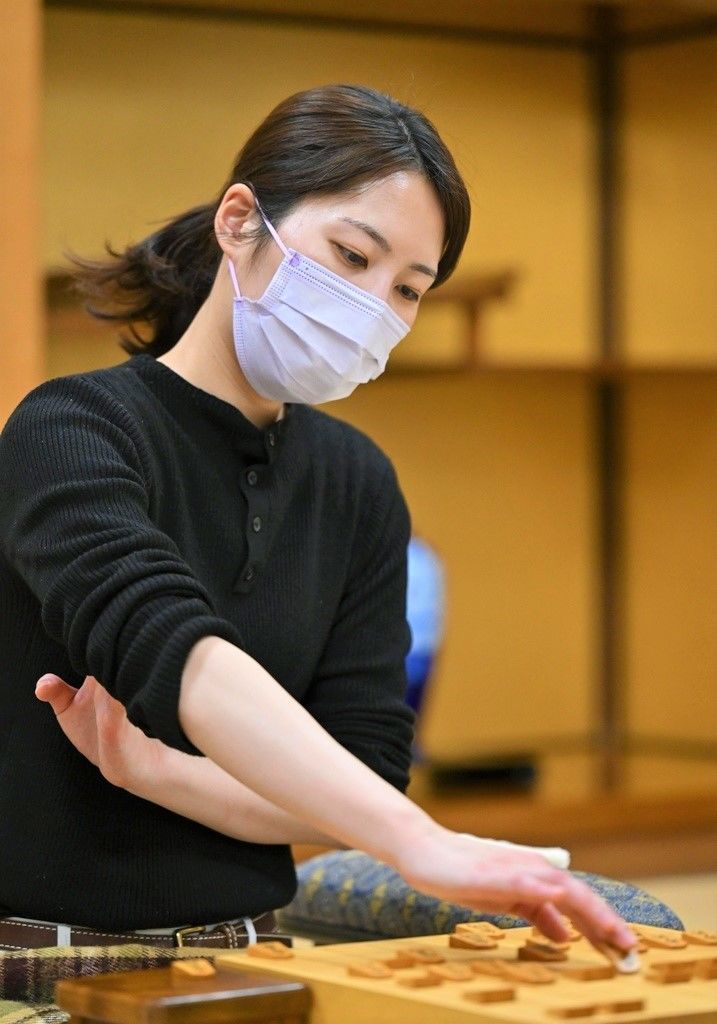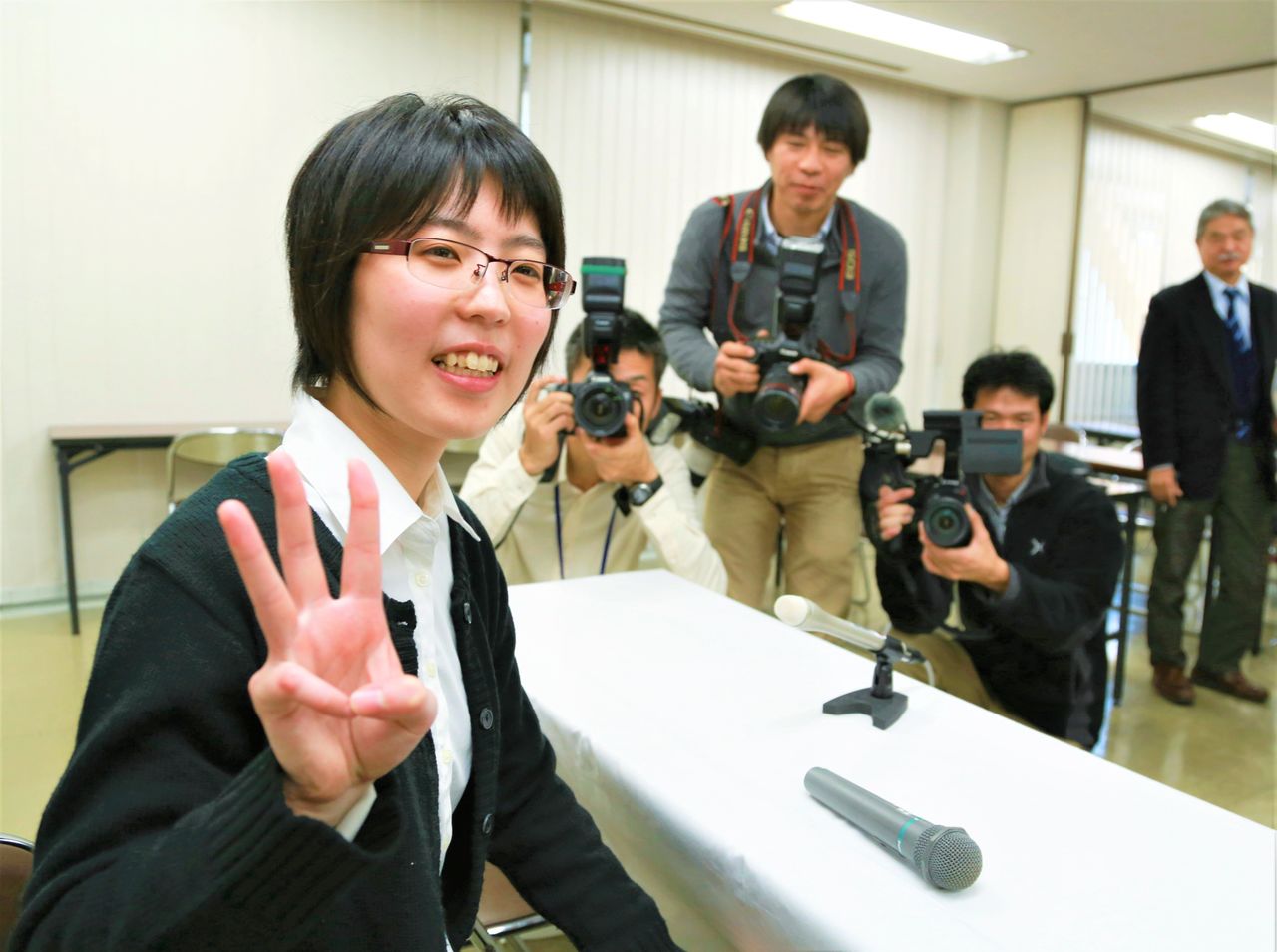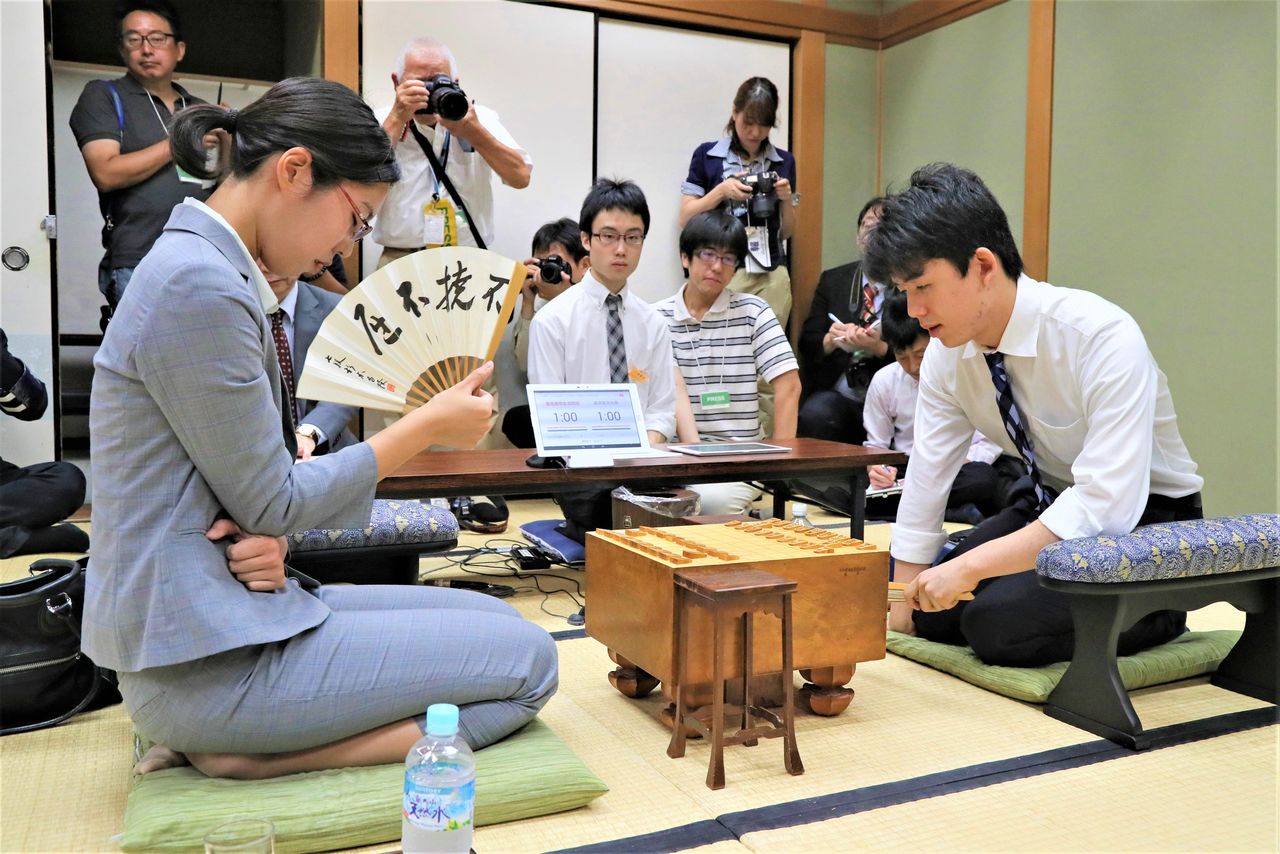
Cracking the “Shōgi” Glass Ceiling: Satomi Kana’s Historic Bid to Break into the All-Male Professional Ranks
Culture- English
- 日本語
- 简体字
- 繁體字
- Français
- Español
- العربية
- Русский
The Traditional Game’s Gender Divide
Star shōgi player Satomi Kana is poised to shake up the male hegemony that has long dominated the top professional ranks of the game in Japan. She has already secured a spot in the record books by claiming five of the eight titles for joryū kishi, the classification for women professionals. Her success on the board has earned her a shot at even greater renown, the chance to become the first woman with full-fledged pro status.
The two professional designations can be somewhat confusing to the uninitiated. Satomi is a joryū kishi, a designation that applies only to women. This is separate from kishi, the so-called regular professionals who constitute the top echelon of players. There are currently some 180 kishi, all men, playing in the top professional ranks.
Gender categories are the norm in sports, but the existence of such a stark divide is out of place in shōgi, a game that prides itself on being a contest of the mind. In principle, anyone with a knack for the game and resolve to put in the necessary practice and study can win promotion to kishi. However, no female player so far has met the stringent requirements, raising the obvious question of what is holding women back.
Without question, deep-running gender bias has traditionally discouraged women from taking up the game. Take, for instance, an interview in the January 1986 issue of the shōgi magazine Kishi sekai (Kishi World) with a retired male player, since deceased, who had this startling comment about women playing the game.
“Women aren’t cut out for shōgi. They’re more suited to simple games like go, mahjong, or golf. With a game like go, they just need to place the stones and forget about them; the complex back-and-forth of shōgi goes right over their heads. It’s a waste of time even trying to teach them. Women should stick to making miso soup. Take my wife, for instance. She doesn’t take the slightest interest in the game.”
Needless to say, such an unapologetically misogynistic view if expressed today would quickly draw fire from all quarters. However, it illustrates that not so long ago there was nothing unusual about men openly espousing sexist ideas, even extreme ones.
While professional shōgi has slowly made room for women, this long legacy of gender discrimination has yet to be swept away. The joryū kishi circuit is a relatively recent invention, and while the level of play among women players continues to improve, this late start is seen as a prime factor in shogi’s gender gap.

Satomi Kana plays a match in the forty-eighth Joryū Kishi Meijin series at the Kansai Shōgi Kaikan in Osaka on February 24, 2022. (© Kyōdō)
The History of Shōgi
Shōgi, which is of ancient, mainland origins, developed into its present form in Japan in the sixteenth century, during the Warring States period (1467–1568). The chesslike game is played on a board of 81 squares arranged in a nine-by-nine pattern, and players start with 20 playing pieces of eight different types. The most distinct aspect of shōgi is the ability to add captured pieces to your own side, placing them on the board at any point of the game, a feature that adds a strategic complexity absent from similar board games.
In the professional game, players, traditionally called shōgi-sashi—a derivative of the Japanese sasu, meaning “to play shōgi”—are organized along the vertical dan ranking system, starting with shodan, or first dan, at the bottom and extending to ninth dan at the top. To move up the ladder, players must defeat increasingly skilled opponents. Those who make it to the pinnacle of the professional rankings compete for a number of prestigious titles, the most revered of these being Meijin.
Professional shōgi-sashi date back centuries in Japan. Their appearance owes much to the patronage of Tokugawa Ieyasu (1543–1616), founder of the eponymous shogunate that ruled Japan for two a a half centuries. Under the support of Ieyasu and his successors, shōgi grew in popularity and prestige. Women were known to take part in matches, but shōgi was traditionally considered a male pastime, and female shōgi-sashi remained a rarity into modern times.
The current structure for professional shōgi took shape during the early part of the twentieth century, at which time the term kishi replaced shōgi-sashi to indicate a professional player. Aspiring young amateurs younger than 19 years old start their careers in the Japan Shōgi Association’s apprenticeship program. Apprenticeship rankings begin at sixth kyū and extend to third dan at the top. Full membership in the JSA is awarded to players when they achieve second dan. Third-dan players who finish first or second in the third-dan league, the qualifying league for professionals, are promoted to fourth dan and awarded the title of kishi.
The first female member of the JSA was Takojima Akiko, a sixth-dan joryū kishi who joined the organization in 1961. She competed against male players but only managed to make it as far as shodan.
Although she failed to reach kishi status, Takojima inspired other women to take up the game. In 1974 the JSA introduced the joryū kishi system for female professionals. The women-only circuit follows the format for kishi, although players are not required to be JSA members, with titles like Joryū Meijin being modeled on established contests. Today, female amateurs, like their male counterparts, come up through the JSA’s apprenticeship system and must notch a set number of wins to earn the title of joryū kishi.
Fast and Furious Play
Satomi, a native of Izumo in Shimane Prefecture, earned the title of joryū kishi in 2004 at the age of 12. She traveled frequently to Tokyo and Osaka to compete, winning the nickname “the Izumo lightning bolt” for her daring attacks. She steadily rose to be one of the top female players. In 2011 at the age of 19 she became a JSA member, setting as one of her goals the elusive kishi title.
In 2013, Satomi, then 21, made history by earning her third dan, the first woman player to do so. She struggled through a tight competition schedule and suffered setbacks like missing matches for health reasons, but in the end she was able to meet the stiff criteria for promotion. This put her in striking distance of becoming a kishi. However, garnering the necessary number of wins in the third-dan league to advance in the rankings proved insurmountable.

A smiling Satomi flashes three fingers during a press conference on December 23, 2013, at the Kansai Shōgi Kaikan in Osaka after becoming the first woman to attain the third dan. (© Jiji)
The third-dan league is a twice-yearly competition consisting of 18 matches played over six months. Players must compete in all of the league’s fixtures, with the top two finishers in each installment of the competition, four players total, being promoted to kishi. Since Satomi competed in the league, around 30 players have risen through it to become regular professionals.
According to JSA rules, players must achieve fourth dan by the time they are 26 or leave the professional apprenticeship system and give up their membership in the association, effectively sinking their chance of becoming a kishi. In 2018, Satomi suffered this fate when she reached the age limit and left the JSA.
Getting a Second Chance
Although no longer a JSA member, Satomi has continued to compete as a joryū kishi. In 2021 she posted a dominant 40–10 record against female opponents, earning her the right to face off against male professionals in certain JSA-sanctioned competitions. She participated in seven such events in 2021, demonstrating her skill on the board by racking up an impressive nine wins against just seven losses.
In 2005, the JSA introduced a second route to becoming a kishi, the pro admission test. That year, Segawa Shōji, who had previously failed to reach kishi under the apprenticeship program, dominated the amateur circuit, earning him the right to participate in a number of professional events. He won the majority of these contests, and feeling he had demonstrated that he was kishi caliber, he petitioned the JSA to give him a chance to qualify for entry into the pro ranks. The JSA agreed and arranged for Segawa to play six games against different opponents, with kishi status hinging on him winning three of the contests. Segawa, who today is ranked sixth dan, passed with flying colors with a 3–2 record.
The JSA has since officially adopted the professional admission test, setting the strict criteria of candidates needing to win at least 10 professional matches with an overall win rate above 65% to be eligible. The tests follow a best-of-five format, with players facing off against kishi opponents. So far only three individuals have passed, and as the first woman player ever to qualify for the pro admission test, Satomi is aiming to beat the odds to become the fourth.

Satomi, left, faces off against teenage prodigy Fujii Sōta during the preliminary round of the Hulic Cup Kisei Tournament at the Kansai Shōgi Kaikan in Osaka on August 24, 2018. The match, which Fujii won, drew broad media attention. (© Jiji)
A Historic Attempt
Satomi, always a strong player, has had an especially strong showing this year. She qualified for the pro admission exam in May by defeating a string of up-and-coming young kishi, posting a 10–4 record for a 71.4% win rate. However, it was unclear if Satomi would take up the challenge. Winning promotion to kishi would add to her already busy schedule as a top player on the joryū kishi circuit, and many insiders speculated that she would pass on the opportunity this time around.
Satomi left her decision to the end of the one-month application period, but on June 28 the JSA announced that she intended to take the professional admission test. Satomi explained her decision in practical terms, saying, “The chance of winning promotion to kishi was a factor, but foremost, I want to see how good I am.“
The buzz within professional shōgi is that Satomi has a 50-50 chance of passing. Although she lost her first match on August 18, the final outcome is anyone’s guess. She may silence doubters by roaring back to win three straight, or she may bow out with a whimper without notching a single victory.
Fans are overwhelmingly in her corner, though, and Satomi has acknowledged their support while also asking for space to concentrate on her matches. All eyes will be on her as she heads into her second game on September 22 in Tokyo, where she hopes to even the score in her historic bid to become the first woman kishi ever.
(Originally published in Japanese. Banner photo: Satomi Kana talks to the press about her decision to take the professional admission test at the Kansai Shōgi Kaikan in Osaka on July 6, 2022. © Kyōdō.)